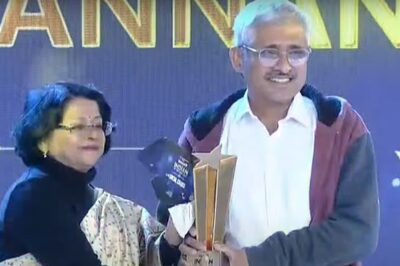
views
Not just during Ganesh Chaturthi, people these days in general are going gaga over being eco-friendly. Be it bags, furniture, actor Allu Arjun’s new farm house or just about anything, the trend is in and the people are living it up to the fullest. Say eco-friendly, and clothing for sure cannot be missed. With an objective to promote handloom and hand-woven clothes and create market for weavers, fashion designers across the country have given into Khadi. Having inspired a lot of them, Khadi has now changed the definition of chic, from just being blingy, bright or sassy to smart, elegant and eco-friendly.
To know what makes khadi more appealing, renowned designer from the city, Asmita Marwa, popular for her usage of khadi and other handloom, predominantly in her collection shares, “It has an earthy appeal, which works well with any kind of embroidery and does not look artificial or synthetic. Living in South-India, Khadi is one such fabric which works really well with our weather. It is breathable and it is easily available. You can get fine and thin khadi for summer and a little thicker for winter.”
She further adds, “When you dye them with natural dyes, the texture of the fabric looks amazing. And there is so much variety of khadi mixed with silk or other fabrics. We should promote our handlooms as these guys cannot compete with mill-made fabrics. It is fashionable now to wear eco-friendly and hand-made.”
Stressing on the fact that even youngsters should embrace it, she gives a few tips on making khadi look glamours. “Dress it up with accessories or mix and match it with denims. You can also try the new Indo-western look like wearing dhoti pants with a shirt, or khadi and linen. It works wonders.”
She also mentions that the fabric needs zero maintenance. “It is a misconception that you have to starch it or iron it and all. The wrinkles look really nice and I love the way it falls. The fabric has some beauty and charm.”
Not just fashion designers, even musicians these days like to go eco-friendly with their attire. One such Bengaluru-based musician Raghu Dixit wears panche, or a khadi dhoti at all of his gigs. What makes him crazy about the fabric? “Khadi works well with our songs as our music is deeply rooted in the Indian literary treasure with a bit of Carnatic music and the attire made it easier for people to relate to. We tried to bring in the folk tradition, by wearing dhoti and bells in our feet.” Also famous for their on-stage attire, vocalist and guitarist of the music band, Swarathma Vasu Dixit says, “I have a personal liking for things made by hand rather than machine made, and khadi is one such example. What I love about khadi is the fact that it directly comes from somebody’s hand. And when they have Batik prints, it’s the perfect combination for me. Its simplicity strikes me and the fact that it can be worn during all the reasons is amazing.”
He then continues, “Since most of them are hand-made they have a natural texture to it, one does not not to put in much effort. Even the finest of the khadi silks have an unevenness to it, and I really like it.
Youngsters are waking up to the call and are going back to the roots. History and fashion will repeat itself. Be it any art forms, the root of the art form will stay longer, like classical music or folk music, people will go back to it. Khadi is the rawest form of making the fabric, no matter what it will always retain it’s glory. With Gandhi Jayanti approaching in just about a week, daram, an initiative of Dastkar Andhra (DA), the Dastkar Andhra Marketing Association (DAMA) has launched Kala Cotton Khadi collection for women and men. Being the only exclusive garments store in Hyderabad dedicated for handloom fabric, daram aims to promote the handloom process and at the same time make good quality garments available to the customer at a reasonable price.
What’s new about this collection? The fabrics are designed in Kala cotton. “Kala is an old-world cotton of the type G.Herbaceum that is endemic to the district of Kutch in Gujarat. It has a short to medium staple length and is genetically very pure. It is also among the most water efficient cottons in the world, which leads to no carbon footprint,” explained a store representative.
In conventional agriculture, majority of the cotton grown in India is Bt Cotton, which is genetically modified hybrid. “All our fabrics are organis, hand-woven and even the block printing is hand-made. Khamir’s organic cotton initiative reintroduces a holistic approach to cotton textile production in harmony with the ecology of Kachchh, by facilitating the linkages of a sustainable local production chain, thus providing income for small and marginal farmers, spinners, ginners and weavers.”




















Comments
0 comment